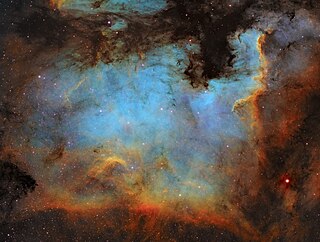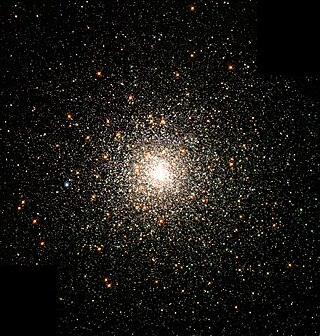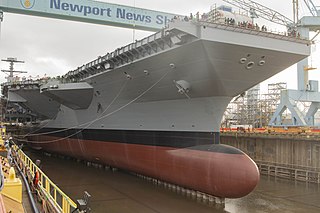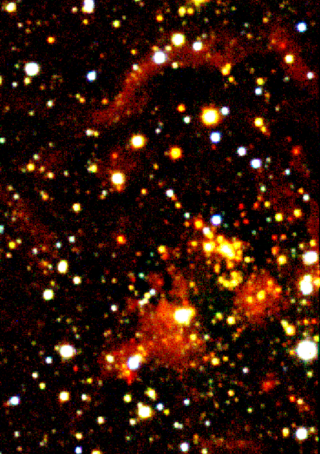Related Research Articles

The North America Nebula is an emission nebula in the constellation Cygnus, close to Deneb. It is named because its shape resembles North America.

In astronomy, metallicity is the abundance of elements present in an object that are heavier than hydrogen and helium. Most of the normal currently detectable matter in the universe is either hydrogen or helium, and astronomers use the word "metals" as a convenient short term for "all elements except hydrogen and helium". This word-use is distinct from the conventional chemical or physical definition of a metal as an electrically conducting solid. Stars and nebulae with relatively high abundances of heavier elements are called "metal-rich" in astrophysical terms, even though many of those elements are nonmetals in chemistry.
An HI region or H I region (read H one) is a cloud in the interstellar medium composed of neutral atomic hydrogen (HI), in addition to the local abundance of helium and other elements. (H is the chemical symbol for hydrogen, and "I" is the Roman numeral. It is customary in astronomy to use the Roman numeral I for neutral atoms, II for singly-ionised—HII is H+ in other sciences—III for doubly-ionised, e.g. OIII is O++, etc.) These regions do not emit detectable visible light (except in spectral lines from elements other than hydrogen) but are observed by the 21-cm (1,420 MHz) region spectral line. This line has a very low transition probability, so it requires large amounts of hydrogen gas for it to be seen. At ionization fronts, where HI regions collide with expanding ionized gas (such as an H II region), the latter glows brighter than it otherwise would. The degree of ionization in an HI region is very small at around 10−4 (i.e. one particle in 10,000). At typical interstellar pressures in galaxies like the Milky Way, HI regions are most stable at temperatures of either below 100 K or above several thousand K; gas between these temperatures heats or cools very quickly to reach one of the stable temperature regimes. Within one of these phases, the gas is usually considered isothermal, except near an expanding H II region. Near an expanding H II region is a dense HI region, separated from the undisturbed HI region by a shock front and from the H II region by an ionization front.

NGC 1232 is an intermediate spiral galaxy about 60 million light-years away in the constellation Eridanus. It was discovered by German-British astronomer William Herschel on 20 October 1784.

USS John F. Kennedy (CVN-79) is the second Gerald R. Ford-class aircraft carrier built for the United States Navy. The ship was launched on 29 October 2019, and christened on 7 December 2019.
A super star cluster (SSC) is a very massive young open cluster that is thought to be the precursor of a globular cluster. These clusters called "super" because they are relatively more luminous and contain more mass than other young star clusters. The SSC, however, does not have to physically be larger than other clusters of lower mass and luminosity. They typically contain a very large number of young, massive stars that ionize a surrounding HII region or a so-called "Ultra dense HII region (UDHII)" in the Milky Way Galaxy or in other galaxies. An SSC's HII region is in turn surrounded by a cocoon of dust. In many cases, the stars and the HII regions will be invisible to observations in certain wavelengths of light, such as the visible spectrum, due to high levels of extinction. As a result, the youngest SSCs are best observed and photographed in radio and infrared. SSCs, such as Westerlund 1 (Wd1), have been found in the Milky Way Galaxy. However, most have been observed in farther regions of the universe. In the galaxy M82 alone, 197 young SSCs have been observed and identified using the Hubble Space Telescope.
HII may refer to:

Okiagari-koboshi or Okiagari-kobōshi is a Japanese traditional doll. The toy is made from papier-mâché and is a roly-poly toy, designed so that its weight causes it to return to an upright position if it is knocked over. Okiagari-kobōshi is considered a good-luck charm and a symbol of perseverance and resilience.

Hiis is a commune in the Hautes-Pyrénées department in south-western France.

In astronomy Westerhout 49 also known as W49, is a strong galactic thermal radio source characteristic of an HII region. It was discovered by Gart Westerhout in 1958.
In astrophysics, photodissociation regions are predominantly neutral regions of the interstellar medium in which far ultraviolet photons strongly influence the gas chemistry and act as the most important source of heat. They occur in any region of interstellar gas that is dense and cold enough to remain neutral, but that has too low a column density to prevent the penetration of far-UV photons from distant, massive stars. A typical and well-studied example is the gas at the boundary of a giant molecular cloud. PDRs are also associated with HII regions, reflection nebulae, active galactic nuclei, and Planetary nebulae. All the atomic gas and most of the molecular gas in the galaxy is found in PDRs.

Huntington Ingalls Industries, Inc. (HII) is the largest military shipbuilding company in the United States as well as a provider of professional services to partners in government and industry. HII, ranked No. 375 on the Fortune 500, was formed on 31 March 2011, as a divestiture from Northrop Grumman.

Estonian Neopaganism, or the Estonian native faith, is the name, in English, for a grouping of contemporary revivals of the indigenous Pagan religion of the Estonian people.

USS Enterprise (CVN-80) will be the third Gerald R. Ford-class aircraft carrier to be built for the United States Navy. She will be the ninth United States naval vessel and third aircraft carrier to bear the name, and is scheduled to be in operation by 2028. Her construction began in August 2017 with a steel-cutting ceremony.

Remy Hii is a Malaysian actor. Hii attended the National Institute of Dramatic Art for three years, and appeared in various theatre productions, before being cast in his first television role. Hii starred as Van Tuong Nguyen in the four-part miniseries Better Man and was cast as Hudson Walsh in the soap opera Neighbours in 2013. He is also known as Prince Jingim from the Netflix original series Marco Polo. From 2018 to 2019, Hii played Simon Van Reyk in the Australian television crime drama Harrow. Hii has also appeared in the series Sisters, the romantic comedy film Crazy Rich Asians, and Marvel's Spider-Man: Far From Home.

Sharpless 2-88 or Sh 2-88 is a region including the diffuse nebula Sh 2-88A and the two compact knots Sh 2-88B1 and Sh 2-88B2, all of which are associated with Vulpecula OB1.

The Hii River is a river on the island of Honshu in Shimane Prefecture and Tottori Prefecture, Japan. With a length of 153 km and catchment of 2540 km2, it is the largest river in the east of Shimane Prefecture. It flows through the cities of Izumo and Matsue and through the lakes Shinji and Nakaumi and discharges into the Sea of Japan.

USS Ted Stevens (DDG-128) is an Arleigh Burke-class guided missile destroyer of the United States Navy, the 78th overall for the class. She will be named in honor of Ted Stevens who served as a U.S. Senator for Alaska for over 40 years. He was also a staunch supporter of both the Navy and the Marine Corps. Ted Stevens will be the third ship of the Flight III of the class.

The Jade Dragon Temple, also known as Yu Lung San Tien En Si, is a Chinese temple located at KM26 of Sibu-Bintulu Road in Sibu, Sarawak, Malaysia. The temple housing the places of worship for Buddhism, Confucianism and Taoism, with the temple complex is considered as the largest not only in Malaysia but believed to be the largest in Southeast Asia as well.

NGC 4848 is a barred spiral galaxy in the constellation Coma Berenices. It is circa 340 million light-years from Earth, which, given its apparent dimensions, means that NGC 4848 is about 170,000 light years across. It was discovered by Heinrich d'Arrest on April 21, 1865. It is considered part of the Coma Cluster, which is in its northwest part. The galaxy has been stripped of its gas as it passed through the cluster.
References
- ↑ Philip Hii (12 October 2010). "Hii bags top three prizes in photo contest". Malaysia Star . Archived from the original on 17 October 2012. Retrieved 3 April 2011.